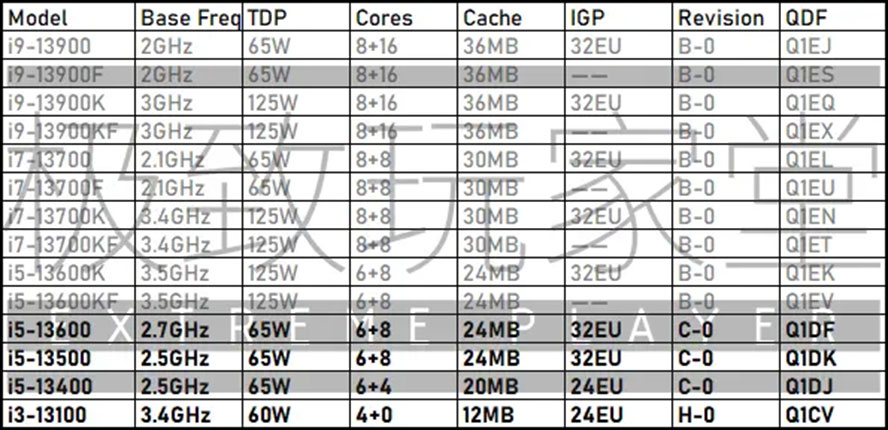Intel Raptor Lake Specs Allegedly Exposed: Up To 24 Cores, 32 Threads
Extreme Player has all the specs for you, from Core i9-13900K to Core i3-13100.
If you are hungry for pre-launch Raptor Lake information, Bilibili-based Extreme Player seems to be a good source of nutrition. The Chinese tech social media man shared his extensive Intel Core i9-13900KF (QS) testing with liquid cooling yesterday. Today, Extreme Player is back with what he claims to be a list of Intel 13th Gen Core processors. He doesn’t claim the specifications to represent the definitive and final Raptor Lake product matrix, but how things stand on August 19, today. Therefore, treat the information with caution.
We already had some excellent ideas about the specs of the Raptor Lake launch chips, which we think will be the ‘three Ks’; the Core i9-13900K, Core i7-13700K, and Core i5-13600K. So, it is good to see some less glamorous non-overclocking chips from Intel detailed, as well as some lower-tier chips that will be picked up by multitudes of gamers and DIYers on a budget.
Extreme Player has included his base clock data for all the chips in the table, but one of the significant omissions enthusiasts will be looking for is the turbo clock data. When quizzed about this omission in the social media post comments, the Chinese hardware enthusiast indicated he couldn’t share these details at this time. Whether he doesn’t know, is holding back information for some reason, or knows there is still time for turbo clocks to change – remains to be seen.
Nevertheless, we can make some interesting observations and comparisons from the base clock data. For example, the new Core i9-13900K/KF reportedly has a base clock of 3.0 GHz. It is 200 MHz slower than its Alder Lake ancestor. The same 200 MHz, gen-to-gen base clock reduction can be seen with Core i7-13700K/KF and core i5-13600K/KF models.
We already knew that efficiency cores would play a more significant part in the processing mix throughout the Raptor Lake family. Extreme Player’s table says every chip in the 13th Gen Core series will allegedly feature at least some E-cores – except the Core i3-13100. This bottom-end Core i3 (the only one in the table) has just four performance cores (plus Hyper-Threading), just like its Alder Lake predecessor. The only observable difference between the Core i3-13100 and core i3-12100 is that the latter has a 100 MHz slower base clock. So despite more cores, cache, and higher frequencies being the signature of Raptor Lake, the poor little Core i3-13100 is an outlier again - with the same 12MB of Intel Smart Cache as the Core i3-12100.
Another feature worth commenting on is how Intel differentiates the Core i5-13500 and Core i5-13400. These chips take a step up the ladder with E-cores on board in the 13th Gen, but the Core i5-13500 takes a 500 MHz step back in base clock gen-to-gen (the Core i5-13400 base clock doesn’t change). Thus, according to this table, the Core i5-13500 and Core i5-13400 are identical except for their E-core quotas, with eight and four, respectively. Admittedly, there may be turbo clock differences when full specs emerge.
Lastly, please remember to take information sourced such as this with a pinch of salt. Extreme Player tacitly admits some of these specs may change between now and the official launch. Nevertheless, it is exciting to see a fuller picture of the Raptor Lake family of CPUs start to emerge from the mist.
Get Tom's Hardware's best news and in-depth reviews, straight to your inbox.

Mark Tyson is a news editor at Tom's Hardware. He enjoys covering the full breadth of PC tech; from business and semiconductor design to products approaching the edge of reason.
-
escksu I just don't quite understand why would you need 16 Ecores for more performance. esp. when E supposed to mean efficient....Reply -
rluker5 Reply
I'm totally excited to get them. I will use parts of them sometimes when I want to bolster my p-cores' serial performance with extra cache and other parts of them when I want more parallel compute capacity. I'll probably use the cache the most, but hey, maybe I'll just enable a set of 4 and process lasso them to the background sometimes.escksu said:I just don't quite understand why would you need 16 Ecores for more performance. esp. when E supposed to mean efficient....
At least they will help more in games than an extra chiplet on the AMD side and if you want the parallel compute that extra chiplet is good for then 16 e-cores could help with that.
Really I find e-cores more useful than secondary chiplet cores, but most of the heavy cpu use for my pc is gaming. I know it is a bit of a pipe dream, but it would be great if the p-cores could use bios idled e-cores' L2 as additional cache. That would really be getting the most out of the silicon. -
spongiemaster Reply
You don't, but that's how the benchmark wars are won. Have to release something bigger and better every year to give people a reason to upgrade.escksu said:I just don't quite understand why would you need 16 Ecores for more performance. esp. when E supposed to mean efficient.... -
jkflipflop98 Replyescksu said:I just don't quite understand why would you need 16 Ecores for more performance. esp. when E supposed to mean efficient....
They come in handy if you're streaming a game or recording footage. Or editing said footage. -
TerryLaze Reply
Well ryzen has shown that there are enough idiots out there that will pay really good money for big multithread numbers even if they don't need it, so why should intel lose out on that?!spongiemaster said:You don't, but that's how the benchmark wars are won. Have to release something bigger and better every year to give people a reason to upgrade.
...Competition?...yay?! ... -
bit_user Reply
In Alder Lake, they offer about 60% the performance of a single thread running on a P-core, while using less than 20% of the power and about 25% of the area. So, they really are a more power-efficient and area-efficient way to scale performance. It's not a scam.escksu said:I just don't quite understand why would you need 16 Ecores for more performance. esp. when E supposed to mean efficient....
The only real down-side the E-cores have is that the OS needs to schedule them effectively. Other than that, they're a pure win for highly-threaded workloads. And for lightly-threaded workloads, you can use all P-cores.
I know E-cores aren't popular among enthusiasts, but I think they get a bad & mostly unjustified rap. I think it was a bold move by Intel and they deserve some credit for taking the risk. -
bit_user Reply
I'm rather sick of people being told they don't need more cores. Anyone who compiles software can almost certainly use more cores/threads. Phoronix regularly tests LLVM and Linux kernel compilation, both of which scale well even up to 256 threads.spongiemaster said:You don't, but that's how the benchmark wars are won.
At my job, a full build of our codebase routinely takes me the better part of an hour. I can't wait until I can upgrade to an i9-12900 (we're an Intel shop, so 5950X isn't an option for me). -
Kamen Rider Blade Reply
I still think that for DeskTop CPU's, the P-Cores & E-Cores should be split into their seperate SKU's.bit_user said:In Alder Lake, they offer about 60% the performance of a single thread running on a P-core, while using less than 20% of the power and about 25% of the area. So, they really are a more power-efficient and area-efficient way to scale performance. It's not a scam.
The only real down-side the E-cores have is that the OS needs to schedule them effectively. Other than that, they're a pure win for highly-threaded workloads. And for lightly-threaded workloads, you can use all P-cores.
I know E-cores aren't popular among enthusiasts, but I think they get a bad & mostly unjustified rap. I think it was a bold move by Intel and they deserve some credit for taking the risk.
No more Hybrid non-sense on DeskTop.
I can easily imagine a world where one CCD/Tile of either 10x P-Cores or 32x E-Cores would rule for the workload you care about.
The upcoming Meteor Lake will have 12x P-Cores or 40x E-Cores per CCD/Tile.
That could be GAME changing for those of us who work highly Multi-Threaded workloads.
And with the rumored FishHawk Falls to be a HEDT replacement,
I can see a Monolithic 24x P-Cores or 96x E-Cores on one die being something very special. -
Kamen Rider Blade Reply
Maybe you guys should start becoming an AMD shop ^_-bit_user said:I'm rather sick of people being told they don't need more cores. Anyone who compiles software can almost certainly use more cores/threads. Phoronix regularly tests LLVM and Linux kernel compilation, both of which scale well even up to 256 threads.
At my job, a full build of our codebase routinely takes me the better part of an hour. I can't wait until I can upgrade to an i9-12900 (we're an Intel shop, so 5950X isn't an option for me). -
bit_user Reply
Why? I don't understand this irrational fear of E-cores. What evidence do you have that they're hurting anything?Kamen Rider Blade said:No more Hybrid non-sense on DeskTop.
Did you know there's this thing called Hyper-Threading, where you get an even worse performance penalty than running a thread on an E-core? And yet somehow operating systems have managed to schedule threads to cores in a way that minimized its impact for like 13 years since Intel re-introduced it?
Intel already said they're not pursuing hybrid CPUs for server, so I don't see this happening. Maybe when their CPUs get broken up into a bunch of tiles, they might segregate the core types just so they don't need quite so many different dies for each market segment.Kamen Rider Blade said:I can easily imagine a world where one CCD/Tile of either 10x P-Cores or 32x E-Cores would rule for the workload you care about.
But they're still going to offer E-cores on desktop, because it's the most power-efficient and area-efficient way to scale performance, period.
